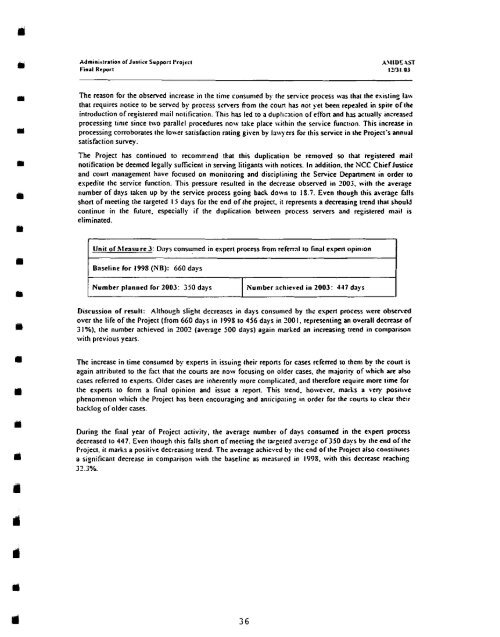2003 - usaid/ofda
2003 - usaid/ofda
2003 - usaid/ofda
Create successful ePaper yourself
Turn your PDF publications into a flip-book with our unique Google optimized e-Paper software.
The reason for the observed increase in the time consumed by the sewice process \\as that the existing l31x<br />
that requires notice to be sewed by process servers fmm the coun has not yet been repealed in spite of the<br />
introduction ofregistered mail notification. This has led to a duplcaion ofeffon and h u actually increased<br />
processing time since two parallcl procedures now take place within the service functton. This increase in<br />
processing corroborates the lower satisfaction ntinp given by layers for this service in the Project's annual<br />
satisfaction survey.<br />
The Project has continued to recommend that this duplication be removed so that registered mail<br />
notification be deemed legally sumcient in serving litigants with notices. In addition. the NCC ChiefJuslicc<br />
and coun management have focused on monitoring and disciplining the Service Depanmcnt in order to<br />
expedite the service function. This pressure resulted in the decrcse observed in <strong>2003</strong>. with the average<br />
number of days laken up by the service process going back do\m to 19.;. Even though this arcnge falls<br />
shon of meeting the targeted I5 days for the end of the project. it represents a decreasing txnd that should<br />
continue in the future. especially if the duplication between process servers and qistered mail IS<br />
eliminated.<br />
Unit of hlcrsure 3: Days consumed in espen process front referral to final expcn opinlon<br />
Baseline lor 1998 (NB): 660 days<br />
I Number planned for <strong>2003</strong>: 350 days I IYuntbcrxhievcd in <strong>2003</strong>: 447 days I<br />
Discussion or result: Although slight decreases in days consumed by the cspen process were obxwcd<br />
over the life of the Project (from 660 da)s in 1999 to 456 days in 1001. representing an overall decreue of<br />
31%). the number achieved in 1001 (average 500 days) a~ain marked an incrcasins trend in compxison<br />
with previous years.<br />
The increase in time consumcd by expens in issuin; thcir repons for cases referred to then, by the cowl is<br />
again attributed to the fact that the courts are now focusing on older cases. the majoriry of xhhich are also<br />
cases referred to cxpens. Older cases are inherently more complicated. and therefore require more tlmc Tor<br />
the expens to form a final opinion and issue a repon. This Ircnd. however. marks a vev positwe<br />
phenomenon which the Project has been encouraging and anticipain: in order for the courts to clex thcir<br />
backlog of older cases.<br />
During the final year of Project activity. the avenge number of days consumed in the espcn pmas<br />
decreased to 447. Even though this falls shon of mectin: the targeted avenge of350 days by the end ofthc<br />
Project, it marks a positive decreasing trend. The avcrazc achiewd by the end ofthc Project also constilutrs<br />
a significant decrease in comparison \rith the baseline as measured in 1998. with this decrease rexhing<br />
22.3%.<br />
--

















